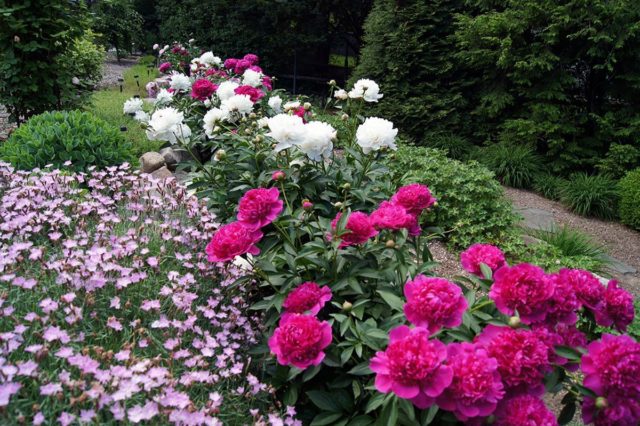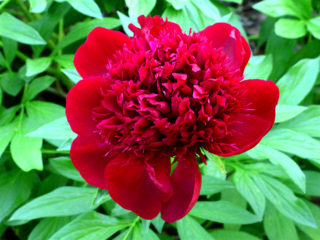Content
Peony Kansas is a herbaceous variety. The perennial plant is grown in various regions. Used for decoration of summer cottages and local areas.
Description of Peony Kansas
A perennial crop grows in one place for about 15 years. The Kansas variety is a herbaceous peony with a high degree of frost resistance. Without additional shelter it can withstand temperatures down to -35 0C.
The plant has satisfactory drought resistance. With proper watering, it feels comfortable in hot climates. The Kansas peony is grown in the European part, in the Urals, in the Central regions, the Middle Zone, in the North Caucasus, in the Krasnodar and Stavropol Territories.
The Kansas variety, created on the basis of a wild-growing milky-flowered peony, has inherited persistent immunity to viral, fungal and bacterial infections. It is affected by pests when they become widespread.
External characteristics of the Kansas variety:
- Peony grows in the form of a compact bush.
Reaches about 1 m in height
- The stems are strong, dark green, rigid, hold their shape well, and slightly disintegrate under the weight of the flowers.
- The leaves are alternately arranged, dark, large, lanceolate, with smooth edges and clearly defined veins.
- The lower part of the peony leaf blade has a small, sparse edge.
- The root system is strong, mixed, and occupies the root circle within 80 cm.
If the peony is planted solo on the site, fixation is not necessary; in its natural form, the Kansas variety looks decorative. Thanks to its powerful root system, the peony grows quickly, forms numerous side shoots and basal shoots. For a full growing season, the plant needs a sufficient amount of light; in the shade, Kansas slows down the growth and formation of buds.
Features of flowering
The first buds appear in the third year of growth, forming singly on the tops of the main stems and side shoots. Flowering period is May-June.
External description of colors:
- the Kansas variety is classified as a double species, the flowers are lush and multi-petaled;
- the flower is large, up to 25 cm in diameter, goblet-shaped, with a pleasant aroma;
- petals are rounded, with wavy edges;
- peony anthers are yellow, stamen filaments are white, elongated;
- The color is a rich burgundy color with a purple tint, depending on the lighting. In the shade, the flowers become duller.

The surface of the petals of the Kansas variety is velvety, delicate
The Kansas peony was awarded a gold medal for its decorative properties. The stems are long, smooth, suitable for cutting. The peculiarity of the Kansas variety is that the more flowers are cut, the more magnificent and brighter the color of subsequent ones will be.
Application in design
Peony Kansas (Kansas) is a herbaceous plant with a branched root system, which makes it difficult to grow this variety in flowerpots. You can place a peony in a pot if its width and depth are about 80 cm. The peony should grow in such a container on a balcony, veranda or loggia, but it will be difficult to move it for the winter due to the weight of the soil. If Kansas is grown under stationary conditions, care must be taken to ensure sufficient lighting for photosynthesis.
Kansas peony is grown in gardens or plots as a design element. Bushes with bright flowers are combined with almost all ornamental crops that do not require an acidic or alkaline environment. Peony develops fully on neutral soils.
In ornamental gardening, the Kansas variety harmoniously combines with the following plants:
- roses;
- bells;
- cornflowers;
- tulips;
- daylilies;
- ground cover varieties;
- euonymus;
- ornamental shrubs;
- dwarf conifers;
- hydrangea.
Peony does not get along well with junipers due to the different composition of the soil. It does not tolerate the proximity of tall, spreading trees that create shade and high humidity.
A few examples of design solutions that include the Kansas peony:
- Used in mass planting with varieties of different colors.
Species with the same flowering period are used
- Mixed with wildflowers to frame the lawn.
Peonies, bells and gladioli harmoniously complement each other
- As a border option.
The bulk consists of red varieties; to dilute the color, a white variety is used
- In mixborders with decorative shrubs in the center of the flowerbed.
Kansas goes well with almost all low-growing plants
- Along the edges of the lawn there is a mix of several varieties of different colors.
Blooming crops give the landscape a complete look
- As a tapeworm in the central part of a rock garden.
The Kansas variety looks aesthetically pleasing against the background of stones
- To create an alley near the garden path.
Peonies emphasize the decorative nature of flowering shrubs
- To design a recreation area.
Kansas against the backdrop of conifers in the barbecue area acts as a color accent
Reproduction methods
Kansas is a varietal, not a hybrid representative of the crop. It produces planting material preserving the characteristics of the mother plant. Peony can be propagated on the site in any way:
- Planting seeds. The material will germinate well, but you will have to wait 4 years for flowering. The generative method is acceptable, but time-consuming.
- Kansas is propagated by layering. In the spring, the stems are sprinkled, the rooted areas are planted the following autumn, after 2 years the crop will form the first buds.
- You can cut cuttings from faded shoots, place them in the ground and make a mini-greenhouse over them. At 60% the material will take root. At the age of two, the bushes are placed on the site; after a season, the peony will bloom.
The fastest and most productive method is by dividing the mother bush. A well-grown peony aged four years or older is suitable for this purpose. The bush is divided into several parts and distributed on the site. Peony Kansas takes root in 90% of cases.
Landing rules
If planting was done in the fall, the peony takes root well and begins to intensively form green mass in the spring. The frost-resistant plant is not afraid of lower temperatures. Planting work in temperate climates is carried out approximately at the end of August, in the south - in mid-September. In spring, planting is possible, but there is no guarantee that the crop will bloom this season.
A place is determined with good air circulation in a lighted area. The Kansas variety does not tolerate shade; it should receive a sufficient amount of ultraviolet radiation most of the day. Peonies are not placed near large trees, as they completely lose their decorative effect in the shade.
The composition of the soil is neutral; if necessary, it is adjusted by adding appropriate products. Dolomite flour is added to acidic ones, and granulated sulfur is added to alkaline ones. The measures are carried out in advance; during autumn planting, the acidity of the soil is adjusted in the spring. The soil chosen is fertile and aerated. Places with stagnant water are not considered for Kansas peony. The crop requires watering, but does not tolerate constant waterlogging.
The pit for the Kansas peony is prepared in advance. The root of the plant is powerful, grows 70-80 cm wide, and deepens about the same. When preparing the holes, these parameters are guided by. The bottom of the pit is covered with a drainage cushion and covered 1/3 of the depth with a nutrient mixture with the addition of superphosphate. The substrate is prepared from peat and compost; if the soil is clayey, then sand is added.
Sequence of work:
- The hole is filled with water, and after drying, they begin planting the peony.
Humidification is necessary to eliminate voids in the substrate
- Cut the stems to the lower vegetative buds.
- Peony buds should be under the soil at a distance of 5 cm. If they are closer to the surface or below the level, the plant will develop poorly in the first year.
- Take a bar wider than the hole, place it on the surface, and fix the plant to it.
The fastening will not allow the kidneys to go deeper
- Cover with soil and water, the root circle is mulched with any material, for decoration you can use pine cones.
Mulch will give the site an aesthetic appearance and maintain soil moisture
Aftercare
Kansas peony care is as follows:
- There is no need to feed the plant until it is three years old; the peony has enough nutrients from the substrate.
- Adult peonies of the Kansas variety are watered with a solution of potassium permanganate in early spring. During shoot formation, ammonium nitrate is added. At the end of spring, the plant is treated with complex mineral fertilizers. When laying buds, feed with superphosphate and potassium supplements.
- Water the bushes with a large volume of water to completely cover the root. The frequency of soil moisture depends on precipitation. Approximately an adult plant needs 20 liters of water for 10 days.
- After watering, be sure to loosen the soil for better aeration and remove weeds. If the plant is mulched, then the grass does not grow and a crust does not form, which means there is no need for loosening.
Trim the plant after flowering, get rid of dried flowers, and shorten the shoots on which they were located. Young stems are not touched. You cannot cut off the leaves or completely all the shoots. At the end of the season, new vegetative buds are laid.
Preparing for winter
Before frost, the plant is pruned so that the length of the stems is no higher than 15 cm. Intensive watering is carried out, ammonium nitrate and organic matter are added. Cover the Kansas variety with straw on top of the mulch. If the planting was carried out in the fall, it is completely covered by stretching burlap over the arches. When dividing a bush, shelter is not relevant.
Pests and diseases
Peony Kansas suffers from powdery mildew only in high humidity. The plant must be transplanted to a favorable area and treated with Fitosporin.
The biological product destroys fungal infection and neutralizes the pathogenic environment
Among the pests, the root-knot nematode poses a threat, affecting the root system. The main spread of the pest is observed in waterlogged environments. Get rid of parasitic insects with Aktara.

The granules are diluted in water and watered under the root of the Kansas peony.
Conclusion
Peony Kansas is a dense and compact herbaceous bush. The variety is distinguished by double flowers of a bright burgundy hue. Created on the basis of a wild-growing milky-flowering species, used for landscape design. The frost-resistant crop is characterized by simple agricultural technology.
Reviews of Kansas herbaceous peony





















